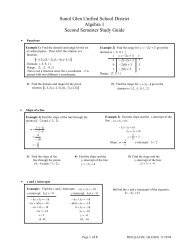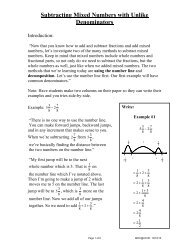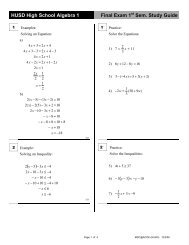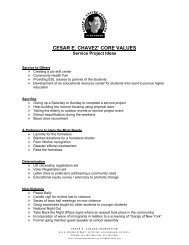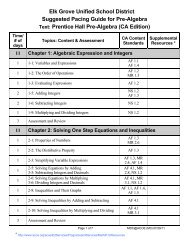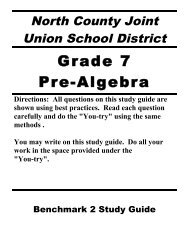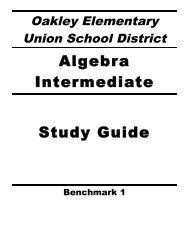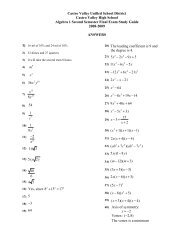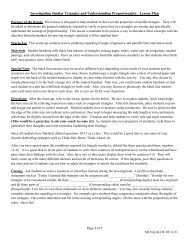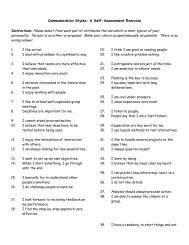Decomposing for Area and Perimeter
Decomposing for Area and Perimeter
Decomposing for Area and Perimeter
Create successful ePaper yourself
Turn your PDF publications into a flip-book with our unique Google optimized e-Paper software.
“The area is 24 square units, <strong>and</strong> the perimeter is 50 units.”“Now, keeping numeric order, see if there can be a base of 2 <strong>for</strong>this rectangle. Since we have a factor of 2 we can use that <strong>for</strong>the base. Now multiply the other factors together to get theother dimension (the height) <strong>for</strong> a rectangle with an area of 24square units.”This rectangle has the dimensions of 2 units x 12 units. “The area is 24 square units, <strong>and</strong> the perimeter is 28 units.”“Now, keeping numeric order again, let’s see…Can there be abase of 3?” [Yes] “We’ll multiply the other factors together tofind the other dimension (the height) <strong>for</strong> a rectangle with anarea of 24 square units.”This rectangle has the dimensions of 3 units x 8 units. “The area is 24 square units, <strong>and</strong> the perimeter is 22 units.”(Repeat these steps, keeping numeric order.) “Now, staying inorder, can we multiply any factors together to get a base of 4?”[Yes, 2 x 2] “Now we multiply the other factors together to getthe height <strong>for</strong> our rectangle.”This rectangle has the dimensions of 4 units x 6 units. Page 6 of 16 MDC@ACOE (3/19/11)
“What is the area of this rectangle?” [24 square units.] “What is the perimeter of this rectangle?”[20 units.]“Now <strong>for</strong> the next rectangle, can there be a base of 5?” [No, 5 isnot a factor of 24] “So we’ll check if there can be a base of6…Are there any factors that we can multiply to create a baseof 6?” [Yes, 2 x 3 ] “Now multiply the rest of the factorstogether to get the height <strong>for</strong> a rectangle with an area of 24square units.” This rectangle has the dimensions of 6 units x 4 units. “What is the area of this rectangle?” [24 square units.] “What isthe perimeter of this rectangle?” [20 units.]Continue following these orderly steps until all possiblerectangle dimensions are found—see rectangles below.This rectangle has the dimensions of 8 units x 3 units. “What is the area of this rectangle?” [24 square units.] “What isthe perimeter of this rectangle?” [22 units.]This rectangle has the dimensions of 12 units x 2 units. Page 7 of 16 MDC@ACOE (3/19/11)
“<strong>Area</strong>?” [24 square units.] “<strong>Perimeter</strong>?” [28 units.]This rectangle has the dimensions of 24 units x 1 units. “<strong>Area</strong>?” [24 square units.] “<strong>Perimeter</strong>?” [50 units.]“Since we have a factor of 1 <strong>for</strong> our height, kept numeric order, <strong>and</strong> used all factors in eachrectangle created, we have found all possible dimensions <strong>for</strong> a rectangle with 24 square units.”Show all rectangles side by side so that students can easily see the changes in dimensions <strong>and</strong>make comparisons.You TryUse factoring to find all possible dimensions <strong>for</strong> a rectangle with an area of 20 square units.20: 1, 2, 2, 5This rectangle has the dimensions of 1 unit x 20 units. Page 8 of 16 MDC@ACOE (3/19/11)
This rectangle has the dimensions of 2 units x 10 units. This rectangle has the dimensions of 4 units x 5 units. This rectangle has the dimensions of 5 units x 4 units. Page 9 of 16 MDC@ACOE (3/19/11)
This rectangle has the dimensions of 10 units x 2 units. This rectangle has the dimensions of 20 units x 1 unit. Frontloading: “Review your rectangles <strong>and</strong> discuss with a partner how to find the perimeter.”[Add, then double/multiply by 2] Leads into using the distributive property <strong>and</strong> <strong>for</strong>mula.Concept Development: <strong>Perimeter</strong>Since we have rein<strong>for</strong>ced using addition <strong>for</strong> finding the perimeter, we now can decompose byaddends to find rectangles with the same perimeter but different areas. Page 10 of 16 MDC@ACOE (3/19/11)
St<strong>and</strong>ard 4MG1.3: Rectangles with the same perimeter have different areas.“We can use what we know about rectangles <strong>and</strong> decompose by addends to prove this st<strong>and</strong>ard.When given that Rectangle 1 has a perimeter of 16 units, our task is to find all the possibledimensions of a rectangle with a perimeter of 16 units.”“What if we started decomposing 16 to 2 +14? Discuss withyour neighbor what the sides of the rectangle would be.” Allowtime <strong>for</strong> discussion <strong>and</strong> drawing their ideas, then ask studentvolunteers to share their thinking. [Dimensions would be 1 x 7because 2 + 14 only shows two sides, so each number needs tobe divided in half.]This rectangle has the dimensions of 1 unit x 7 units. “Remember to keep numeric order <strong>and</strong> you will be able to find all the (whole number) differentdimensions <strong>for</strong> a rectangle with a perimeter of 16.”Ask students to discuss amongst themselves if it is possible <strong>for</strong> a rectangle to havefractions/decimals as its dimensions; support <strong>and</strong> give examples. [Yes; sample response: 4.25inches <strong>for</strong> the base <strong>and</strong> 5.5 inches <strong>for</strong> the height.] Confirm this with students, <strong>and</strong> share thatsince the st<strong>and</strong>ard <strong>for</strong> 4 th grade regards whole numbers, we will only focus on using wholenumbers while we are developing the concept.“We started decomposing the perimeter of 16 units in our first rectangle as 2 + 14. Rememberthat we want to keep order, <strong>and</strong> use only whole numbers as the base <strong>and</strong> height, which meansthat we should decompose the perimeter of our second rectangle as 4 + 12; the next step is todecompose each of these addends in half, as 4 + 12 only represents two sides of the rectangle.” Page 11 of 16 MDC@ACOE (3/19/11)
This rectangle has dimensions of 2 units x 6 units. “Let’s decompose the dimensions <strong>for</strong> rectangle 3, following thesame steps <strong>for</strong> rectangles 1 <strong>and</strong> 2. We’ll start the decomposingwith a base of 6 <strong>and</strong> height of 10, then take half of eachaddend.”This rectangle has the dimensions of 3 units x 5 units. “Now we’ll follow the same steps to find the dimensions <strong>for</strong>rectangle 4. What base should we start with?” [8, then divide inhalf]This rectangle has the dimensions of 4 units x 4 units. “How should we start decomposing <strong>for</strong> the fifth rectangle?” [10 + 6, then decompose eachaddend in half.] Page 12 of 16 MDC@ACOE (3/19/11)
This rectangle has the dimensions of 5 units x 3 units. “How will we start decomposing <strong>for</strong> the sixth rectangle?” [12 +4, then decompose each addend in half.]This rectangle has the dimensions of 6 units x 2 units. “How do we start the seventh rectangle?” [14 + 2, thendecompose each addend in half.]This rectangle has the dimensions of 7 units x 1 unit. Have students discuss the relationship <strong>and</strong> the patterns they seein the rectangles; make <strong>and</strong> display posters. While working ingroups of 2 or 3, challenge them to come up with different waysto write the perimeter <strong>and</strong> share their ideas.[P = 2(b) + 2(h); P = 2 (b + h)]Discuss the perimeter <strong>for</strong>mula. Have students use the perimeter <strong>for</strong>mula <strong>for</strong> all the rectangles. Page 13 of 16 MDC@ACOE (3/19/11)
Page 15 of 16 MDC@ACOE (3/19/11)
<strong>Perimeter</strong> SolutionsConcluding Notes: While the concepts <strong>and</strong> skills are not too challenging, <strong>and</strong> the use of<strong>for</strong>mulas is not difficult <strong>for</strong> students to grasp, the opportunity to decompose numbers <strong>and</strong>manipulate them into given areas <strong>and</strong> perimeters helps to develop a strong number sensefoundation. Page 16 of 16 MDC@ACOE (3/19/11)




